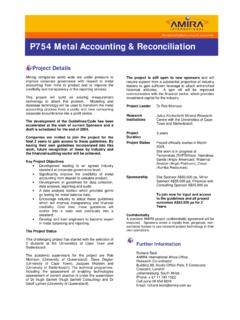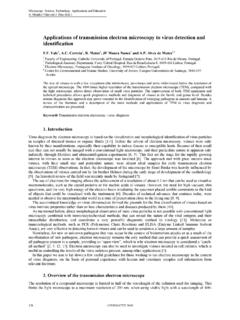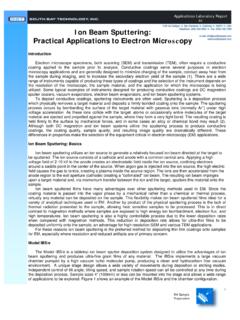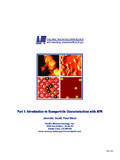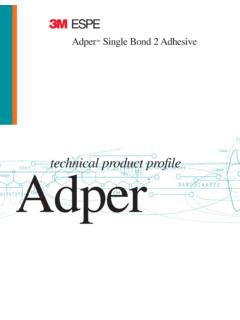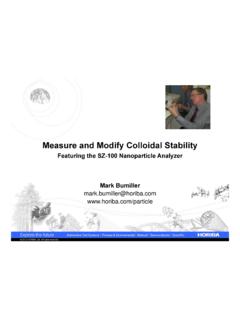Transcription of Processing of Nickel Ores & Concentrates ‘10 Falmouth ...
1 Processing of Nickel Ores & Concentrates 10 Falmouth Beach Hotel, Falmouth , UK, June 17-18, 2010 Sponsored by: Thursday 17th June Opening Remarks J. Wills (MEI, UK) and Lotter (Xstrata Process Support, Canada) Technical Session 1 Chairmen: T. Norgate (CSIRO, Australia) and . Girgin (Hacettepe University,Turkey) Reductive dissolution of ferric iron minerals: a new approach for bioprocessing Nickel laterites Hallberg, Grail, Johnson (Bangor University, UK) and C. du Plessis (BHP Billiton, Australia) Oxidative bioprocessing of sulfidic ores and Concentrates to recover metals has developed into a thriving area of biotechnology, known generically as biomining . Significant reserves of some metals also occur in oxidized (ferric iron) ores, such as Nickel laterites.
2 We have used bacteria to catalyse the reductive dissolution of goethite (the major Nickel host mineral in ferric iron limonitic laterites) and thereby liberate the associated Nickel . Acidithiobacillus ferrooxidans, which can grow in the absence of oxygen using elemental sulphur as electron donor and ferric iron as electron acceptor, was used to bioprocess representative ore in an anaerobic bioreactor under conditions of controlled pH and temperature. Over 70% of the Nickel present in the ore was solubilised within 14 days from <6 mm crushed ore limonite with a low Nickel grade of The acidic (pH ) conditions at which tests were carried out caused the Nickel to remain in solution. The results suggest that biological Processing of Nickel laterites is technically feasible and, more generically, that reductive dissolution can be used to bioprocess oxidized mineral ores.
3 Selective reduction and sulphidation of nickeliferous laterites C. Harris, J. Peacey and Pickles (Queen s University, Canada) Processing of nickeliferous laterites to produce Nickel metal is process and energy intensive. Since most laterites are found in less developed regions, capital costs for infrastructure can exceed those for the process. The low temperature sulphidation of lateritic ores to produce an intermediate Nickel concentrate for further Processing offers a potentially lower energy and simpler alternative. The sulphidation of nickeliferous lateritic ores was investigated over a range of temperatures and conditions. A DTA/TGA with mass spectrometer was used to elucidate reaction mechanisms and determine reaction kinetics, and a combination of electron microprobe and high resolution scanning electron microscope were used to characterize the reaction products.
4 Coffee Assessing the sustainability of Nickel laterite Processing T. Norgate and S. Jahanshahi (Minerals Down Under National Research Flagship, CSIRO, Australia) While currently accounting for only about 40% of world Nickel production, laterite Processing is expected to grow significantly in the future in order to balance the long-term supply of Nickel as production from sulphide ores falls off. Given this anticipated expansion in Nickel laterite Processing , it is important that the various Processing routes for Nickel laterite ores, both existing and proposed, be assessed from a sustainability point of view. To this end, a number of hydrometallurgical and pyrometallurgical Processing routes for Nickel laterite ores were assessed using life cycle assessment (LCA) methodology, focussing in the first instance on energy consumption and greenhouse gas emissions.
5 The Processing routes assessed were: hydrometallurgical high pressure acid leach, enhanced pressure acid leach, atmospheric leach, heap leach; pyrometallurgical ferronickel process; combined hydrometallurgical/pyrometallurgical Caron process. The results of this study are presented in the paper, including a comparison of the various Processing routes. Reductive leaching of Nickel laterite G. Senanayake, J. Childs and A. Winn (Parker Centre, Murdoch University, Australia) The reductive leaching of Nickel laterite has attracted renewed interest of many researchers due to the enhanced leaching kinetics of Nickel and cobalt in the presence of acids and reducing agents and the application of reducing agents in atmospheric, pressure or heap leaching processes.
6 Systematic studies based on chemical species, potential-pH diagrams and measured rate data based on synthetic oxides and natural ores can shed light on the reaction mechanism which leads to investigate beneficial reagents for further studies. This paper describes a comparative study of metal leaching from synthetic goethite and laterite ores to shed light on the role of reducing agents in acid or alkaline media. Results are rationalised on the basis of the effect of speciation, chemical reactivity of mixed oxide systems and heterogeneous kinetic models. Rheological behaviour of Nickel laterite smectite ore slurries Das, N. Kelly and Muir (CSIRO Process Science and Engineering (Minerals), Australia) The characterisation and rheology of several Nickel laterite (nontronite-rich) smectite ores and pure minerals are compared to assess the effect of mineralogy and particle size on the rheology of the pulps.
7 Studies have been carried out with smectite ores in the presence of pure goethite, maghemite, hematite, talc, kaolin and magnesite. A vane viscometer was used to determine the pulp density that gave an optimum yield stress of 100 Pa for pumping slurries. In general, smectite ores exhibit poor rheological behaviour in comparison with goethite < kaolin < talc < hematite < maghemite < magnesite and the finer fractions were more viscous than the coarser fractions. Blending smectite ores with other minerals improves the optimum yield stress by up to 5% w/w. A good linear correlation was found between the viscosity and the settling density of laterite ores which provides a simple measure of predicting the rheological behaviour of slurries.
8 The variation in the viscosity of laterite ores depends largely on the mineralogy and the particle size distribution. However, the correlation of surface area with rheology was a poor fit. Lunch Technical Session 2 Chairmen: C. Harris (Queen s University, Canada) Dissolution behaviour of a Turkish lateritic Nickel ore . Girgin, A. Obut and A. yildiz (Hacettepe University,Turkey) The atmospheric pressure sulphuric acid leaching characteristics of Adatepe (Eski ehir-Turkey) laterite ore that has recently been put into operation was investigated. The effects of sulphuric acid concentration (5-95%), temperature (20-95 C) and time (30-240 minutes) on leaching were determined by Nickel , iron and arsenic analyses.
9 The amounts of Ni, Fe and As in solution were observed to increase with the increase of temperature from 25 C to 70 C for sulphuric acid concentrations between 5 to 95%. Further increase of temperature to 95 C showed that the dissolution of Ni, Fe and As were increased until 60% sulphuric acid concentration and over 60% a decrease in the dissolution behaviour was observed. Experimental results showed that maximum Nickel dissolution of at 95 C could be reached in 120 minutes leaching time for a sulphuric acid concentration of 60%. The congruency of Ni dissolution with respect to Fe was investigated and Fe was found to be as congruent over about 25% Ni and 20% Fe dissolution values at 95 C. The causes of the discrepancy in Nickel and iron dissolution and the lowering in the dissolution values over sulphuric acid concentrations of 60% at 95 C are being investigated considering the mineralogical composition of the ore and the leaching conditions.
10 An update on the application of MRT to separations of interest in the Nickel and cobalt industry Izatt, Izatt, Bruening and Dale (IBC Advanced Technologies, Inc., USA) IBC Advanced Technologies Molecular Recognition Technology (MRT) SuperLig products, selectively and rapidly binds with target metal ions to remove them from solution. The MRT process can produce a high purity separation product of maximum added value at low cost. This paper provides a review of some examples of applications for MRT related to Nickel and cobalt Processing streams including recovery of Ni and Co from PAL streams and removal of minor contaminants from cobalt Processing streams. Isasmelt TSL applications for Nickel Bakker, S.

